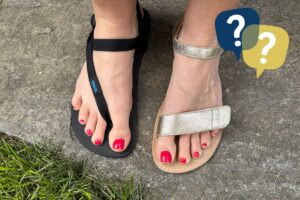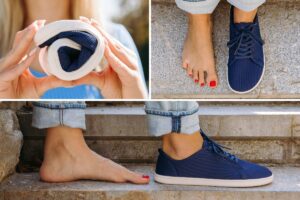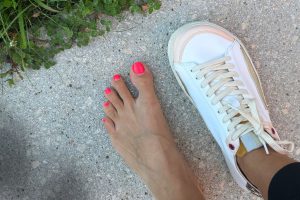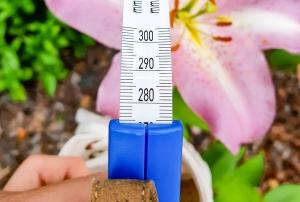Ultimate Guide: How to Measure Feet for Barefoot Shoes

Knowing the correct length and width of your feet is one of the first and most important steps when buying barefoot shoes, especially online. These measurements are essential not only for comparing with size charts to determine if a model is right for you but also for ensuring a proper fit across different brands and styles. Understanding how to measure your feet accurately is crucial for selecting the perfect barefoot shoes.
Why Knowing Your Foot Length and Width is Important
Shoes from different brands can have different size charts, and even different models from the same brand can have varying lengths. So, you may not necessarily have the same size in all barefoot brands.
It is also important to measure the width of your feet for shoes, as not all barefoot shoes fit all foot widths. Although barefoot shoe manufacturers try to create models that fit a wide range of people, not all barefoot shoes are suitable for all foot widths and shapes.
What fits your friend may not necessarily fit you.

How to Accurately Measure Your Feet for the Best Barefoot Shoe Fit
Measuring your feet accurately is the first essential step in selecting the right barefoot shoes. Here’s how to measure your feet properly:
- Measure Both Length and Width: Before purchasing online, always measure the length and width of your foot and compare these values with the size charts provided by the shoe manufacturer or shop. Enough space in the shoe is essential for proper foot function.
- Understand Your Foot Type: Besides length and width, understanding your foot type is important. Feet differ in volume, toe box shape, etc. This information helps in choosing shoes that accommodate your unique foot structure.

Tips for Accurate Foot Measurement
- Measure in the Evening: Feet tend to swell throughout the day, so measuring in the evening gives you the most accurate reading.
- Be Barefoot or in Toe Socks: Measure your feet either barefoot or in the socks you plan to wear with that specific shoe. Some socks can take up quite a lot of space, affecting the fit. Make sure you do not measure your feet wearing classic socks.
- Stand on a Hard, Flat Surface: Always stand on a hard, flat surface while measuring to ensure accuracy.
- Measure Both Feet: Feet can be of different lengths and widths, so it’s essential to measure both and use the larger measurement when choosing shoes.
- Always Measure in Centimeters: This unit of measurement is more precise than inches and is commonly used by most footwear brands in their size charts, ensuring greater accuracy when comparing your foot measurements to the recommended shoe sizes.
The Best Methods for Measuring Foot Length and Width
There are different ways to measure the length and width of your feet for barefoot shoes, but here are three of the most common ones:
Foot Tracing Method
Suitable for measuring foot length and width.
Steps:
- Stand on a piece of paper with your feet pointing straight ahead.
- Have someone else trace around your foot with a thin, sharp pencil held vertically.
- Measure the vertical distance from the center of the heel to the longest toe (length) and the width as the horizontal distance at the widest part at the ball of the foot (unless there are different instructions given by the manufacturer).




Note: When making a tracing, it is not necessary to trace every curve of the toes or the arch of the foot precisely. It is important to capture all the key points to make the measurement.
How to Measure Width of Feet for Shoes?
Measuring the width of your feet can be done in several ways, but the most common methods for barefoot shoes are measuring the widest part at the ball of the foot, as shown in methods a) and b) in the photo. However, the method you choose should ideally align with how the shoe brand measures their shoes. Since there isn’t a standardized way to measure width across all brands, it’s always a good idea to check with the specific brand to understand their measurement guidelines. This will help you get the most accurate comparison and ensure the best fit.

Wall Method
Suitable for measuring foot length.
Steps:
- Stand with your heel against a wall, foot flat on the floor.
- Mark the tip of your longest toe.
- Measure the distance from the wall to the mark (length).

Using a Plus12 Meter
Suitable for measuring foot length and shoe length.
Steps:
- Step on the Plus12 meter with your heel gently touching the back.
- Point the red tip at your longest toe.
- Read the value on the Plus12, which already includes the recommended 12 mm space for movement.



How to Measure Kids’ and Baby Feet for Shoes
Measuring kids’ feet is no different than measuring feet for adults. If kids are old enough to follow directions and stand on the paper or against the wall, measuring is an easy task. However, if the kids are smaller, you will need another adult to help you.
It’s important for the child to be standing with their full body weight on their feet so they can spread and widen properly. While taking the measurement, hold the child’s foot firmly, while the other adult distracts them. Make sure you mark the key points you need to measure the width and length – it is not necessary to make a full trace as the part under the arch can be more ticklish.
How to Find Out Your Barefoot Shoe Size in Size Chart?
Manufacturers use different ways of measuring shoes (there is no standardized method), but usually, the internal length and width of the shoe are given in the size charts, like here for an example:

This size chart shows the inside length of the shoe, which is the most common type of size chart, while some also provide the recommended foot length. If the chart shows the inside length, you should add approximately 12 mm to your foot length to find your ideal size. While this extra space may seem excessive, it’s actually crucial for allowing your toes to move freely, and you’ll quickly get used to this newfound freedom.
Of course, the space you need in front of your toes also depends on the type of shoe (winter models, sandals, etc.), your age (kids need space to grow too!), and how well the shoe shape matches your foot shape. As a general rule of thumb, you should have at least a few millimeters of space between your toes and the shoe, even when you’re squatting or walking.
Width measurements in size charts can be more complex and tricky because they try to describe three-dimensional feet and shoes with two-dimensional measurements. Due to the many factors that influence how the width feels inside the shoe—such as the volume of the shoe and foot, the design of the sole, materials used, etc.—and the different measuring techniques (measuring horizontally, diagonally, or at different points), the value recorded in the size chart is not always consistent or unchanging. So, a shoe might sometimes feel wider or narrower depending on how it’s designed and the shape of your foot.

What’s important to remember is that when determining whether the width of a shoe is appropriate, you should always make sure that your toes can find their natural position inside the shoe.
Conclusion: The Path to Perfect Barefoot Shoes – Measure, Choose, and Test
Accurately measuring your feet is the first and most crucial step in finding the perfect pair of barefoot shoes. While differences in measuring methods and sizing charts can make this process challenging, taking the time to get precise measurements and comparing them to the manufacturer’s size charts will help you make an informed decision.
Once you’ve chosen your shoes, it’s essential to give them a proper test run. Ensure the shoe fits well in terms of width, length, and how securely it stays on your foot. For more detailed guidance on choosing and testing barefoot shoes, join us at the Barefoot Universe Academy, where we help you every step of the way to find your perfect fit.







